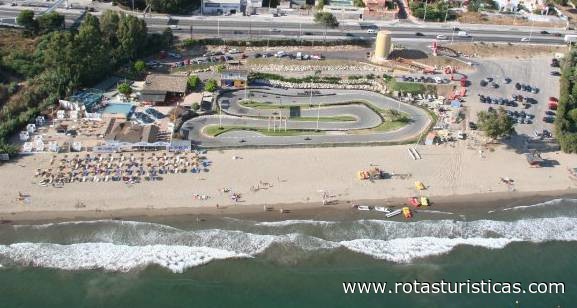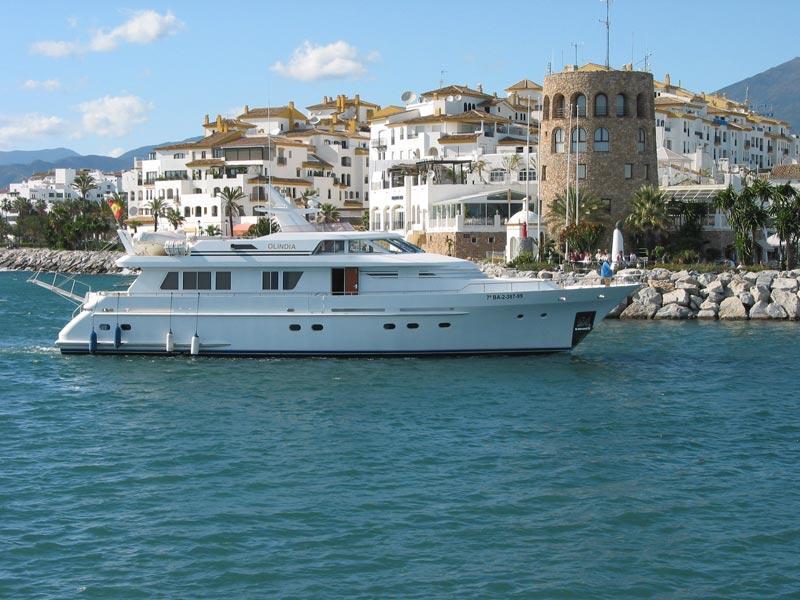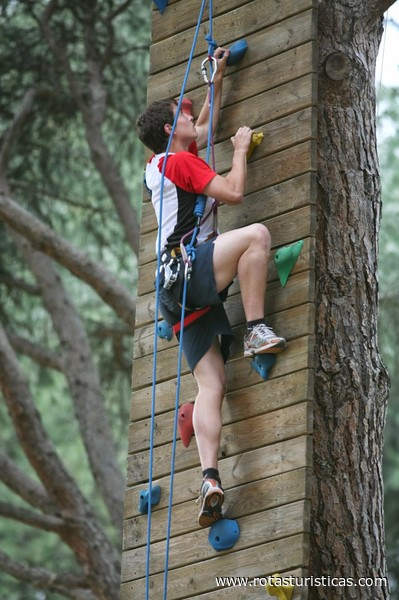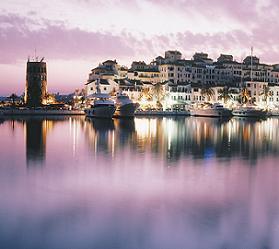Marbella, Andaluzia, Spain
Suggest Place to Visit
2300
Track to location with GPS |
 |
Miguel Nieto.
The widespread species that Marbella is a municipality that emerged practically from nowhere, a fishing village with no history or roots that only owes its name and its label to tourism development, constitutes one of the most bloody fallacies, and no less widespread , about this city.
Marbella has a historical stem, its creation dates back to more than a millennium before Christ and it was never a small village that lived on the sardines that its nets harvested. Even in the nearest past, it always remained an important city that, in any case, lived on its countryside, its agriculture and its mining. Tourism development, its more than deserved international fame, was later earned.
However, it is difficult to locate the origins of the city that some scholars identify with the Greek Mainake, others with the Roman Salduba, and others with the Cilniana, also Roman, although this would be closer to the current San Pedro Alcántara. Ptolemy and the Roman historian Pomponio Mela already spoke of Salduba, a city located near Malaca (Malaga) and Laccipo (north of present-day Casares). What is undoubted, controversial nomenclature aside, is that an important urban nucleus already existed in Roman times and that, surely, the settlement was even older. In fact, dating back to ancient times, in the surroundings of the city, as in the cave of Pecho Redondo, significant Neolithic remains were found. The Roman vestiges found certify that we already had a city of considerable dimensions. One of the first historians to be interested in our past, Vázquez Clavel in the seventeenth century, found in his excavations, hot springs on Calle Muro, foundations on Calle Carmen and Ortiz de Molinillo, coins and vessels in the renovation works of the old town hall, and some square-shaped piles in the Plaza de los Naranjos itself.
ROME.
Fernando Alcalá, the city's official chronicler, agrees with the assessment of his colleague and maintains that the medieval old town was built on the ruins of a Roman city, which he identifies with Salduba, whose elements would later be reused (for example, in his castle, in which were used ashlars and even an Ionic capital for its walls) by the Arabs.
But there are more Roman vestiges in the municipal area, such as the Roman baths located south of San Pedro Alcántara, or the Roman town of Río Verde. The hot springs popularly known as Las Bóvedas, seem to belong, according to the latest excavations carried out, to an old recreational mansion from the end of the Roman Empire. The farm was large, it had aqueducts to bring water to the farm and the baths and, probably, according to the remains found in the tastings, it maintained a salting industry. Possibly the precious Roman ´´garum´´. Today the vaults of the thermal bath (hence its name) are preserved. The Roman villa, which was excavated on the banks of the Rio Verde by the archaeologist Carlos Posac, maintains some of its mosaics in fairly good condition, among which its culinary motifs and its central motif La Gorgonia stand out.
Another of the most remarkable historical monuments of Marbella is the early Christian basilica of Vega de Mar, of national archaeological interest with its double apse. This excellent archaeological find was made in 1930 by Professor Pérez de Barrada. It is a small temple that dates back to the 4th century after Christ.
MUSLIM MARBELLA.
The Muslims, who invaded the peninsula in the 8th century, recognized the strategic value of the population. In the 12th century, the historian Al Idrisi defined it as ´´a small but well-inhabited city´´. Its population was estimated in these times at about 3,000 inhabitants. The Muslims fortified it and its many vestiges have survived, with unequal luck, until today. The most important is, without a doubt, the Castle, bastion of the citadel. The walled enclosure of the medina gathered about 90,000 square meters of streets. In addition, the entire coastline had several beacon towers (of signals) that made it possible to monitor incursions from the other side of the Mediterranean. Later, the Catholic Monarchs and Carlos V rebuilt some and ordered others to be built with a similar purpose, although in this case they watched over Barbary itself. Marbella was in Arab times a city of gardens and crops, among which figs and fruit trees stood out for their fame. There were also numerous mulberry trees dedicated to silk. The Castle is considered, according to Fernando Alcalá, a caliphal work from the 10th century, which was expanded in the Nasrid period.
Carlos Posac believes that in some of its fronts the remains of Roman temples were used, the fortified perimeter of the city had three gates, Ronda de Málaga and del Mar, names that still remain in the local toponymy.
King Ferdinand the Catholic, in his advance towards Granada, conquered the city with ease on June 11, 1485. Since then, the saint who is honored on this day, the Cypriot Bernabé, has become the patron of the city and the place where the Moorish leader gives the keys to the king is called the Cruz de Humilladero. Despite what is commonly believed, the name is due to the fact that it was Fernando himself who humbled himself to thank God for having taken the city without bloodshed, and not because the Moorish king did so as a sign of submission.
FORTIFICATION.
The Catholic Monarchs decide to reinforce the defenses of the city. that also underwent great changes internally. Alcalá highlights the construction of several chapels, the convent of the Holy Trinity, almost attached to the walls and of which today only a few battered arches are preserved, and the Hospital of San Juan de Dios, intended for sick foreigners. In the Plaza de los Naranjos stands the hermitage of Santiago and outside the convent of San Francisco, already demolished. New streets were opened, among which the Nueva street that connected with the Puerta del Mar and gave access to La Marina would stand out.
Other notable works are the Alonso de Bazán hospital, built by the former warden in 1568 and which today has become the Museum of Contemporary Spanish Engraving and headquarters of the Delegation of Culture, and the prison. Of the latter, there is no vestige either, since the new Town Hall was built there and the old town hall is preserved, with a beautiful coffered ceiling, and several murals in what is now the Office of the Mayor, a few years ago a municipal museum and in the seventeenth century courtroom. The tempera frescoes represent Saints Justa and Rufina, a crucified Christ and an imperial shield of Spain.
The Church of the Incarnation, whose bell tower was the highest point in the city for decades, was built in 1618. The Habsburgs also promoted the development of the city and from this period important vestiges are preserved, such as the house of the magistrate, in the
Marbella is, by its own merits, one of the main destinations on the Costa del Sol. Its excellent climate, its beaches, its natural environment and its important sports complexes are just some of the innumerable attractions that this municipality on the Malaga coastline offers.
Good proof of the high quality of its infrastructures is Puerto Banús, one of the most emblematic places in Marbella. Surrounded by exclusive developments, this famous marina welcomes some of the largest and most luxurious yachts in the world every year. Its facilities also offer a leisure area made up of restaurants, venues and shops of large international fashion and luxury goods firms.
From Cabopino to Guadalmina, Marbella offers visitors a beautiful 26 kilometer coastline with sunny beaches endowed with all kinds of services, including modern hotels, residential complexes, shops and restaurants. The beaches of San Pedro de Alcántara, an important town located less than ten kilometers from Marbella, are a good example of harmony between nature and tourist development.
Sports lovers will find a paradise in Marbella. A dozen magnificent golf courses allow you to practice this modality at the highest level throughout the year, in the midst of places of unusual natural beauty.
Those who opt for nautical sports will find in this town three ports where they can start in the specialty they want.
Likewise, Marbella has various equestrian schools, tennis clubs and other equipment that will satisfy the most diverse tastes. All this, without forgetting the enormous possibilities that Sierra Blanca offers to practice all kinds of outdoor sports.
The historic center of Marbella
At the foot of Sierra Blanca, in front of a beautiful bay, the historic center of Marbella is located. A beautiful layout that exhibits its Andalusian character through its neat whitewashed facades adorned with bars and geraniums or in the orange trees that appear in every corner.
The heart of the town is located in the Plaza de Los Naranjos, from the Renaissance period, flanked by noble buildings such as the town hall (16th century) and the old Casa del Corregidor (17th century).
In the plazuela de la Iglesia is the Iglesia Mayor de la Encarnación, built in the 16th century. In this same environment stands one of the towers that were part of the old Arab fortress of the city, from the 9th century.
Witnesses of the Roman origin of the city are the abundant archaeological sites found in the area, among which the paleo-Christian basilica of Vega del Mar, the Guadalmina hot springs or the Roman town of Río Verde stand out.
The great cultural offer in Marbella is completed with the Museum of Contemporary Spanish Engraving, considered the most important in Spain of its kind. Located in the Bazán Hospital (16th century), it houses an interesting collection of engravings from the 19th and 20th centuries, with works by great masters such as Picasso, Miró or Dalí.
Gastronomy, parties and surroundings
The fried fish, the ajoblanco (cold soup with almonds, oil and garlic) or the gazpacho are some of the tasty suggestions of the gastronomy of Marbella. Excellent sweet dessert wines are made under the Malaga Denomination of Origin.
Within the festive calendar of Marbella, it is worth highlighting the San Bernabé Fair and Festivities, which is celebrated during the first fortnight of June. Its program includes concerts, bullfighting festivities and other activities.
Holy Week and the patron saint festivities of San Pedro de Alcántara, which take place in October, are other special dates.
From Marbella you can make countless excursions along the Costa del Sol. A few kilometers from this town appears Mijas, a typical mountain town that offers a great tourist offer on its coast. Torremolinos, Estepona, Benalmádena and Fuengirola are other towns with a deep-rooted tourist tradition.
Nature offers incredible landscapes in the Sierra de las Nieves Natural Park, in the middle of the Ronda mountains. In the heart of Sierra Blanca, very close to Marbella, are Istán, a town famous for its springs, and Ojén, of great ecological wealth.
Comments
We don´t have yet any comments about:
Marbella city
Marbella city
Be the first to leave a comment as it is very important to inform other people
Outros locais a visitar
Within a radius of 20 km from:Marbella city
Aquatime, S.L |
| 1,7 Km |
 |
Funny Beach |
| 2,6 Km |
 |
Puerto Banús |
| 6,7 Km |
 |
Aventura Amazonia |
| 10,2 Km |
 |
Hotel reservation near Marbella city within a radius of 20 km
Why to book with ROTTA TURISTICA
The best prices
Our partnerships with the world´s largest operators offer research on the best market prices.
More options
At Rotas Turisticos you can book the hotel, buy the air ticket, book the transfer from the airport to the hotel and vice versa, book the local excursions, rent the car, take travel insurance and consult the places to visit and where to go.
Holiday Tips & Destinations
Hundreds of holiday destinations with all the options that allow you to easily choose the destination that best suits your dream vacation.
ROTTA TURISTICA
Links






